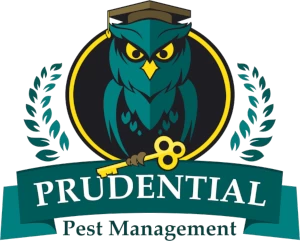Stored Product Moths and Grain Beetles
Indian Meal Moths and Grain Beetles
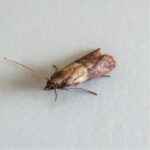 Do you have moths or beetles in your kitchen? Bugs in your kitchen are often pantry pests. These pests are found in food left too long, often in the back of the cupboard, or food spilled under equipment that may be out of reach from regular cleaning. Indian meal moths and grain beetles such as the red flour beetle infest foods high in grains such as flour, cereal, bird seed, cat food, dog food, and other boxed grain in the pantry or kitchen area.
Do you have moths or beetles in your kitchen? Bugs in your kitchen are often pantry pests. These pests are found in food left too long, often in the back of the cupboard, or food spilled under equipment that may be out of reach from regular cleaning. Indian meal moths and grain beetles such as the red flour beetle infest foods high in grains such as flour, cereal, bird seed, cat food, dog food, and other boxed grain in the pantry or kitchen area.
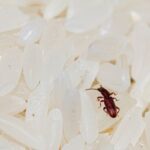 Control for this kitchen pest can be as easy as finding the source and discarding it in the trash. We recommend sifting through all your stored foods for the start of the infestation. Indian meal moth larvae (maggots) will often crawl out into corners of the kitchen and leave silk webs in the food. Red flour beetles are tiny little reddish brown ones usually found near the source.
Control for this kitchen pest can be as easy as finding the source and discarding it in the trash. We recommend sifting through all your stored foods for the start of the infestation. Indian meal moth larvae (maggots) will often crawl out into corners of the kitchen and leave silk webs in the food. Red flour beetles are tiny little reddish brown ones usually found near the source.
Bugs Eating your Clothing Carpets, or Animal Hides
Hide Beetles
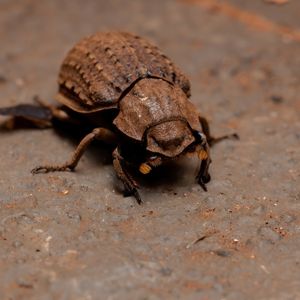 Dermestidae is a Coleoptera family commonly referred to as skin beetles. Other common names include larder, hide or leather beetle, carpet beetle, and khapra beetle. There are approximately 500 to 700 species worldwide. They can range in size from 1 to 12 mm. Key characteristics for adults are round, oval-shaped bodies.
Dermestidae is a Coleoptera family commonly referred to as skin beetles. Other common names include larder, hide or leather beetle, carpet beetle, and khapra beetle. There are approximately 500 to 700 species worldwide. They can range in size from 1 to 12 mm. Key characteristics for adults are round, oval-shaped bodies.
Dermestids have a variety of habits; most genera are scavengers that feed on dry animals or plant material, such as skin or pollen, hair, feathers, dead insects, and natural fibers. Members of Dermestes are found in animal carcasses, while others may be found in a mammal, bird, bee, or wasp nests. These beetles are significant in forensic entomology.
Some species are known to be associated with decaying carcasses, which helps with criminal investigations. Some species are pests and can cause extensive damage to natural fibers in homes and businesses. They are used in taxidermy and natural history museums to clean animal skeletons. Some dermestid species, commonly called “bow bugs,” infest violin cases, feeding on the bow hair.
Dermestid beetles are destructive to several everyday items. Natural fibers such as wool, silk, cotton, linen, fur, or feathers are more prone to attack than synthetic fibers. Dermestids are also known to attack chocolate, copra, and cocoa beans. Most damage is done by the beetle’s larval stage, while adults feed on flowers and shrubs.
The Common Clothes Moth
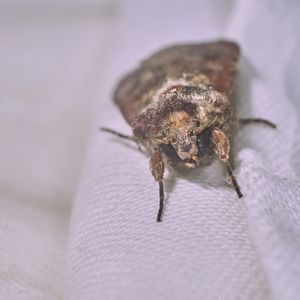 Females lay eggs in clusters of between 30 and 200, which adhere to surfaces with a gelatin-like glue. These hatch four and ten days later into near-microscopic white caterpillars, which immediately begin to feed. They will also spin mats under which to provide without being readily noticed and from which they will partially emerge at night or under dark conditions to acquire food.
Females lay eggs in clusters of between 30 and 200, which adhere to surfaces with a gelatin-like glue. These hatch four and ten days later into near-microscopic white caterpillars, which immediately begin to feed. They will also spin mats under which to provide without being readily noticed and from which they will partially emerge at night or under dark conditions to acquire food.
The life cycle may be completed within one month under the most favorable conditions but may take several years.
Unlike the caterpillars, the adult moths do not feed: they acquire all the nutrition and moisture they need while in the larval stage, and once they hatch from cocoons, their only goal is to reproduce. They have only atrophied mouth parts and cannot feed on fabric or clothing. All feeding damage is done by the caterpillar (larval) form. Heated buildings allow clothes moths to develop year-round. The life cycle from egg to egg typically takes 4–6 months, with two generations per year.
Clothes Moth
Clothes moth larvae are notorious for feeding on clothing and natural fibers; they can digest keratin protein in wool and silk. The moths prefer dirty fabric and are particularly attracted to carpeting and clothing containing human sweat, or other organic liquids spilled onto them; traces of dirt may provide essential nutrients for larval development. Larvae are attracted to these areas not only for food but for traces of moisture; they do not require liquid water.
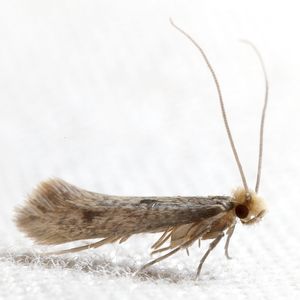 The recorded foodstuff range includes cotton, linen, silk, wool fabrics, and furs. They will eat synthetic fibers if they are blended with wool. Furthermore, they have been found on shed feathers and hair, bran, semolina and flour (possibly preferring wheat flour), biscuits, casein, and insect specimens in museums.
The recorded foodstuff range includes cotton, linen, silk, wool fabrics, and furs. They will eat synthetic fibers if they are blended with wool. Furthermore, they have been found on shed feathers and hair, bran, semolina and flour (possibly preferring wheat flour), biscuits, casein, and insect specimens in museums.
Everyday clothes moths seem to prefer dim or dark areas. If larvae find themselves in a well-lit room, they will try to relocate under furniture or carpet edges. Handmade rugs are a favorite because it is easy for larvae to crawl underneath and do their damage from below. They will also crawl under moldings at the edges of rooms in search of darkened areas where fibrous debris has gathered and which consequently hold good food.
Go to top
Prudential Pest Management handles Stored Product Pest problems using a variety of products and or heat systems. Call now for a free quote. (810)410-8563
Prudential Pest Management services the following areas in Michigan:
Genesee County, Tuscola County, Lapeer County, Oakland County, Livingston County, Shiawassee County, Saginaw County, Burton, Clio, Davison, Fenton, Flint, Flushing, Grand Blanc, Linden, Montrose, Mount Morris, Swartz Creek, Gaines, Goodrich, Lennon, Montrose, Otisville, Otter Lake, Clayton Township, Fenton Township, Flint Township, Flushing Township, Genesee Township, Grand Blanc Township, Montrose Township, Mount Morris Township, Mundy Township, Vienna Township, Argentine Township, Atlas Township, Davison Township, Gaines Township, Richfield Township, Thetford Township, and Forest Township. We service all communities in Genesse and its surrounding counties.
